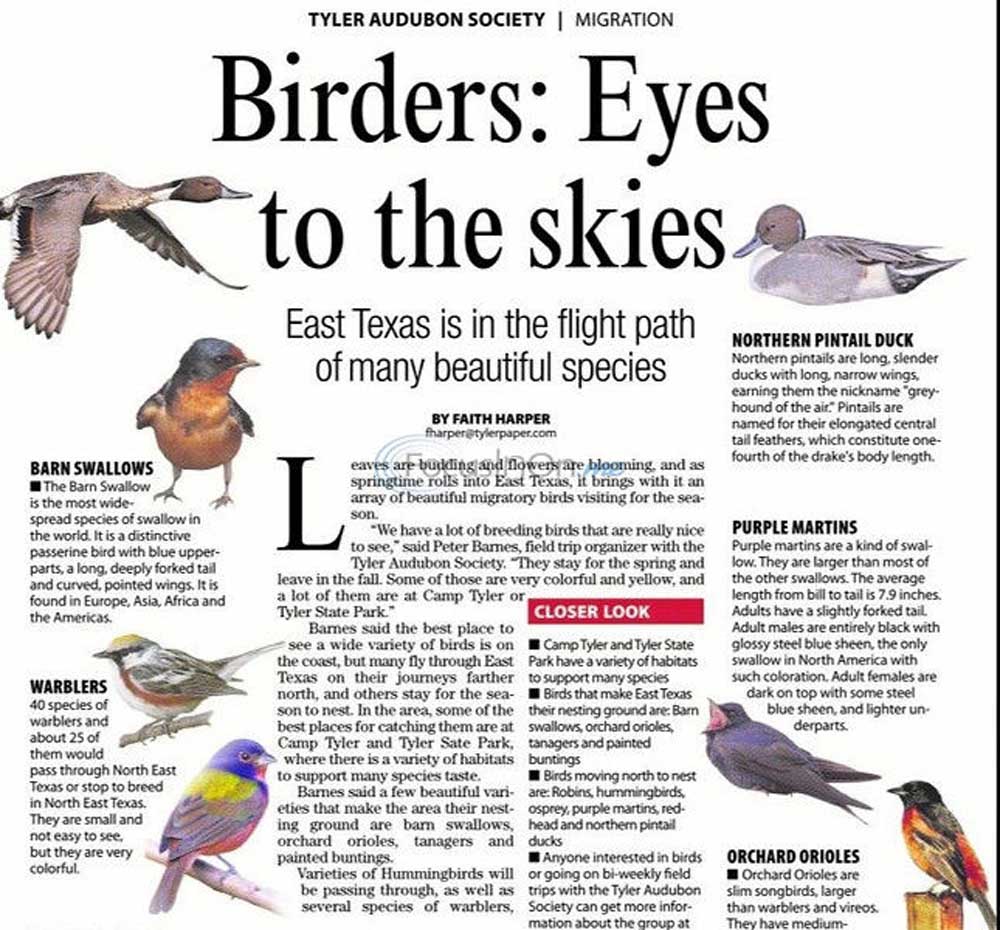Birders: Eyes to the skies – East Texas is in the flight path of many beautiful species
Published 10:53 pm Wednesday, March 12, 2014

- By Faith Harper fharper@tylerpaper.com
Leaves are budding and flowers are blooming, and as springtime rolls into East Texas, it brings with it an array of beautiful migratory birds visiting for the season.
“We have a lot of breeding birds that are really nice to see,” said Peter Barnes, field trip organizer with the Tyler Audubon Society. “They stay for the spring and leave in the fall. Some of those are very colorful and yellow, and a lot of them are at Camp Tyler or Tyler State Park.”
Barnes said the best place to see a wide variety of birds is on the coast, but many fly through East Texas on their journeys farther north, and others stay for the season to nest. In the area, some of the best places for catching them are at Camp Tyler and Tyler Sate Park, where there is a variety of habitats to support many species taste.
Barnes said a few beautiful varieties that make the area their nesting ground are barn swallows, orchard orioles, tanagers and painted buntings.
Varieties of Hummingbirds will be passing through, as well as several species of warblers, which are a small but colorful breed of birds, Barnes said. Purple martins are starting to trickle into the area and will be more visible as summer progresses, and few birds of prey will stop by, including osprey, which can be seen in the spring and fall around local lakes.
“(There are) about 40 species of warblers and about 25 of them would pass through North East Texas or stop to breed in North East Texas. They are small and not easy to see, but they are very colorful,” Barnes said. “They are very flashy birds.”
Corey Mason, Region 3 director for Texas Parks and Wildlife, said male birds are the most vibrant, and their colors will be brighter while they look for a mate.
“Their plumage is pretty…” Mason said. “The males are very showy for females — they are attracting a mate. Males are more bright, while the females are duller. They’re the ones that don’t want to be the bright (and) … draw undue unneeded attention to the nest.”
As some species move into East Texas, others will be moving further north to nest, including Robins, which make the area their home for the winter. Several duck species are also leaving, including redhead and northern pintail species, Barnes said.
Homeowners can also attract some guests with bird feeders. The experts suggest putting bird feeders close to homes so the birds cannot get enough speed to hurt themselves if they fly into a window. They also suggest the feeders be up high enough to avoid cats, and to put bells on animals so the birds have a chance of getting out of harm’s way.
Mason also suggests going ahead and cleaning out old feeders and putting in fresh feed. He said a clean feeder reduces bird-specific infections and diseases.
The type of feed and the contraption itself can influence the species that stop by. Mason said thistle seed is loved by many smaller birds, and a general-mixed feed with milo, sunflower and wheat seeds is good to attract a variety of birds.
Small feeders attract only small birds, but a larger feeder bay feed squirrels as well, Mason said.
Bird baths are also a good addition.
“The good thing about bird baths is … (they attract) lots of different kids kinds of species — backyard squirrels, butterflies in the spring and birds have good access to them,” Mason said.
He also suggests putting rocks or stick inside the baths if it is overflowing to allow a landing spot for winged animals.
“It’s a fun time of year,” Mason said. “Over the next several months there will be lots of different bird species that will come to Texas to see us.”
Anyone interested in birds or going on bi-weekly field trips with the Tyler Audubon Society can get more information about the group at www.tyleraudubon.org.







